It looks like you're using an Ad Blocker.
Please white-list or disable AboveTopSecret.com in your ad-blocking tool.
Thank you.
Some features of ATS will be disabled while you continue to use an ad-blocker.
Asteroid BC15 ("discovered" yesterday) closer than Tu24 and it's closest dist. to earth is Today?
page: 1share:
After getting into the whole Tu24 asteroid thing I became more interested in this subject. It appears that asteroid BC15 is coming closer to the
earth TODAY than Tu24 ever did. Look at the link below.
ssd.jpl.nasa.gov...
If you do it hour by hour it looks like the closest is .0019 AU (1 AU = approx 149,598,000 km). This means that it will be approximately 176,616 miles from earth at its closest. Also it appears that it is going roughly four times faster than Tu24 and it was discovered yesterday if you believe the link below:
hea-www.harvard.edu...
This link says that it's closest distance is .002 so that is in close agreement with the first link. The brightness will be 50% less than Tu24 though. It does not appear to be hazardous per this page but I want to know if this is common that they discover an asteroid this close to earth only the day before its closest point? Please advise. Thanks.
[edit on 31-1-2008 by Moserious]
[edit on 31-1-2008 by Moserious]
[edit on 31-1-2008 by Moserious]
ssd.jpl.nasa.gov...
If you do it hour by hour it looks like the closest is .0019 AU (1 AU = approx 149,598,000 km). This means that it will be approximately 176,616 miles from earth at its closest. Also it appears that it is going roughly four times faster than Tu24 and it was discovered yesterday if you believe the link below:
hea-www.harvard.edu...
This link says that it's closest distance is .002 so that is in close agreement with the first link. The brightness will be 50% less than Tu24 though. It does not appear to be hazardous per this page but I want to know if this is common that they discover an asteroid this close to earth only the day before its closest point? Please advise. Thanks.
[edit on 31-1-2008 by Moserious]
[edit on 31-1-2008 by Moserious]
[edit on 31-1-2008 by Moserious]
Holy Cr*p! yesterday? are we going through an eliptical belt that we didn't know existed?
Nice catch. I see the 0 observation days.
Whew, feel so safe ; )
Whew, feel so safe ; )
Here is another table that shows the miss distance as .8 LD:
neo.jpl.nasa.gov...
The link also says that it is 12 to 27 meters (39-88 feet). I still want to know if objects of this size are only usually "discovered" once they are about a day away or is this late "discovery" unusual? Also, if something of this size was coming right at earth would it burn up in the atmosphere or not? I am guessing that it depends on what it's made of, but what size asteroids are dangerous? 88 feet seems kinda big but I want to know what size asteroid may not "burn up". Basically, is there a size threshold for being dangerous?
This kinda makes me think that even if an asteroid is coming at earth we may never know it because it may only be "discovered" right before it hits. Maybe a good thing though.....
neo.jpl.nasa.gov...
The link also says that it is 12 to 27 meters (39-88 feet). I still want to know if objects of this size are only usually "discovered" once they are about a day away or is this late "discovery" unusual? Also, if something of this size was coming right at earth would it burn up in the atmosphere or not? I am guessing that it depends on what it's made of, but what size asteroids are dangerous? 88 feet seems kinda big but I want to know what size asteroid may not "burn up". Basically, is there a size threshold for being dangerous?
This kinda makes me think that even if an asteroid is coming at earth we may never know it because it may only be "discovered" right before it hits. Maybe a good thing though.....
I don't think anyone can tell you if it would burn. It depends on size, shape, and type of matter. If its soft stone, probably down to a VW bug size?
Nickle or iron it would be a big bullet.
Wow, this is a little more than half the distance to the moon from us and close to 100 feet across, if it was Iron it would do some serious damage to
a populated area.
Guys, it is over and gone. (till the next time around) According to the hourly ephemeris I looked at, it already passed us at .8 LD about 4 hours
ago....at that speed I don't think gravity would effect it much. However, how accurate could their data be if they haven't observed BC15 before
yesterday. Anyone here anything else related to this? Like I said it appears to have already happened and as TU24 it was a non-event (other than some
weather changing effects)
if it's dimmer (smaller and less reflective) AND going faster then i'd say it's no wonder they couldn't see it sooner. makes sense to me.
because it was traveling at high speed, you can't really say it was because we were passing through any "belts". we do go through them several times a year though:
stardate.org...
this is probably just a rock that orbits the sun with a very off-balance focus and probably comes around once every few 10's or 100's of years. the faster it goes the longer orbital period it will have.
what effects were there? i'm honestly curious.
[edit for spelling]
[edit on 31-1-2008 by an0maly33]
because it was traveling at high speed, you can't really say it was because we were passing through any "belts". we do go through them several times a year though:
stardate.org...
this is probably just a rock that orbits the sun with a very off-balance focus and probably comes around once every few 10's or 100's of years. the faster it goes the longer orbital period it will have.
...(other than some weather changing effects)...
what effects were there? i'm honestly curious.
[edit for spelling]
[edit on 31-1-2008 by an0maly33]
Originally posted by an0maly33
what effects were there? i'm honestly curious.
Well, if you look in these threads there is usually a post that eventually links to real-time information of the magnetosphere that surrounds the earth and protects us from the suns' solay rays (containing higher energy radioactive particles, such as x-ray and gamma rays). If you look at the graphs there were some huge changes in the pressure, temperature, and densities during the passing of TU24 and now it appears to be changing again in the passing of BC15.
As for specific weather changes worldwide? I am not a meteorolgist or a scientist, but mankind is gaining knowledge rapidily of how the middle and upper atmospheres (and higher layers, such as the ionsphere and magnetosphere) effect weather on the planet with electrical and magnetic energy exchanges between them and the earths' solid mass.
Everywhere I read people seem to be having significant weather changes (ie - snow in Baghdad last week for the first time in recent history) One of these threads had a link to a report by a Russian scientist laying out what he called recent weather effects from the changes I am describing. I would link to it but I fear it is buried somewhere in the 100+ page "TU24-has NASA concerned" thread.
I know the weather is strange where I live, Corpus Christi Tx.
The temperatures after fronts usually vary by 5-7 degrees, meaning the low may be 45 and the high 50-52 etc..
We got a front in yesterday evening, the temperature went down from about 75 to 52 but by around midnight it was back up to 70.
We just got another front in, the wind is blowing about 35, which is normal and its slowly cooling back down.
We have a freeze warning for tomorrow morning but tomorrows highs are expected to be back up around 70.
so, this week we are having temperature differences that vary between 20-35 degrees which for us is pretty unusual.
Maybe theres something to it and the other 90 foot asteroid that came even closer to earth yesterday??
The temperatures after fronts usually vary by 5-7 degrees, meaning the low may be 45 and the high 50-52 etc..
We got a front in yesterday evening, the temperature went down from about 75 to 52 but by around midnight it was back up to 70.
We just got another front in, the wind is blowing about 35, which is normal and its slowly cooling back down.
We have a freeze warning for tomorrow morning but tomorrows highs are expected to be back up around 70.
so, this week we are having temperature differences that vary between 20-35 degrees which for us is pretty unusual.
Maybe theres something to it and the other 90 foot asteroid that came even closer to earth yesterday??
reply to post by percievedreality
perceivedreality:
Here are the links you are talking about I think:
Home page:
www2.nict.go.jp...
"Latest Images" page:
www2.nict.go.jp...
Here are the most recent pictures and you are right the "pressure" of the magnetosphere is up (shown by white and red). This information is directly from the links above:
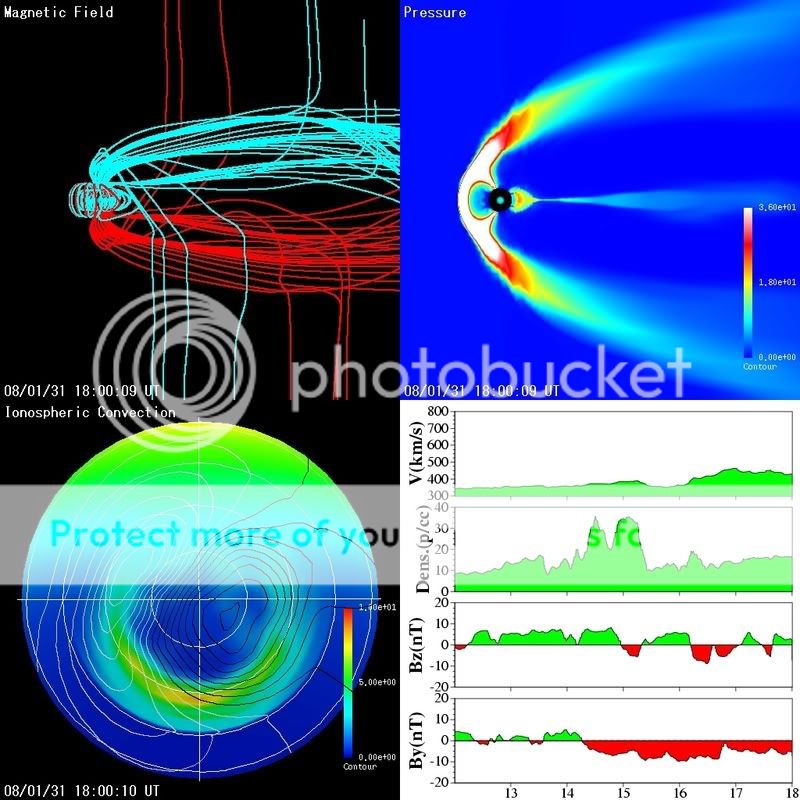
And here are the graphs that go with the "most recent" data:
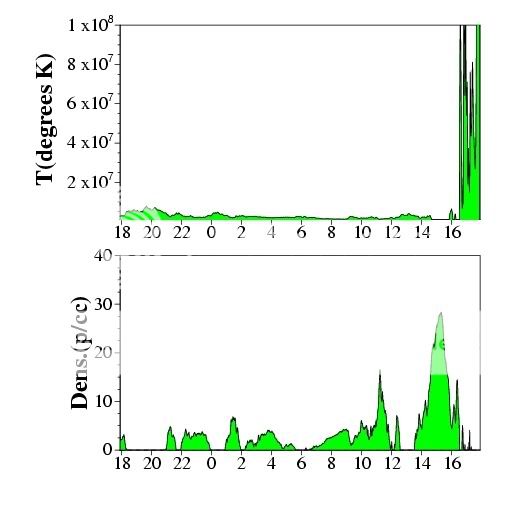
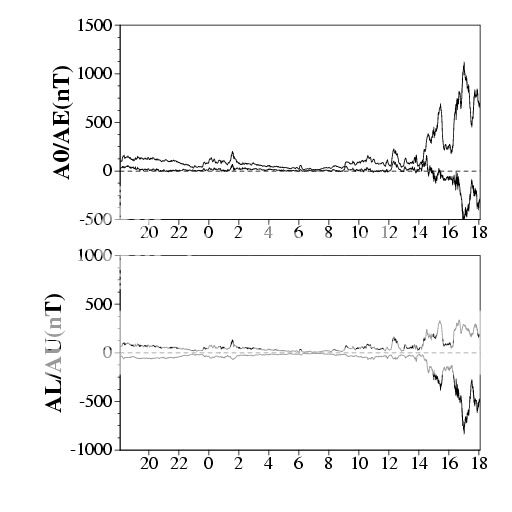
For comparison purposes here are is an image from around the time Tu24 was at its closest:
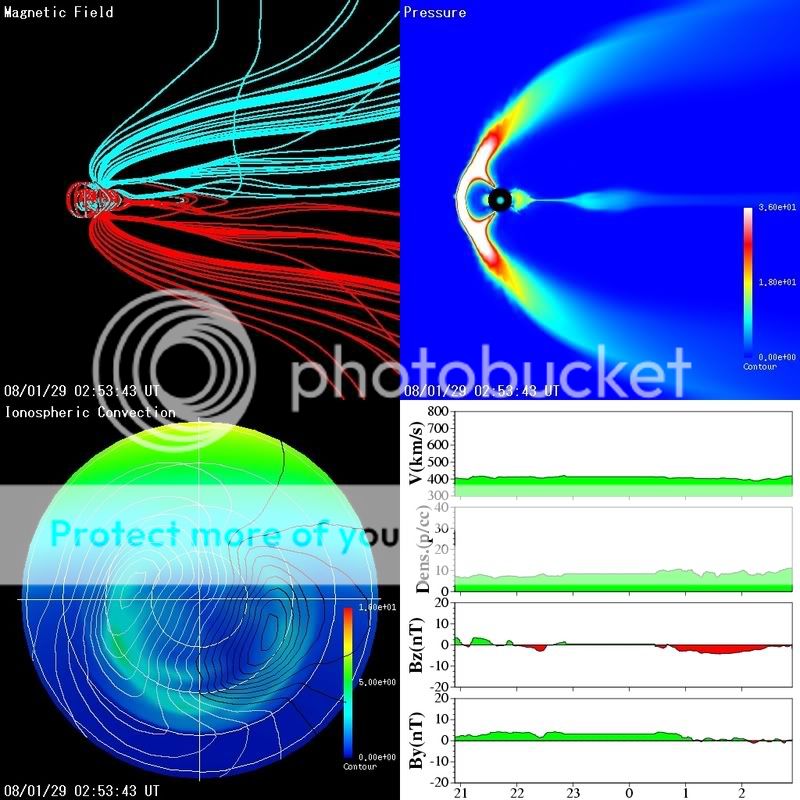
And here are some images from the day before Tu24 was nearest. Notice the change in color ("pressure" I think):
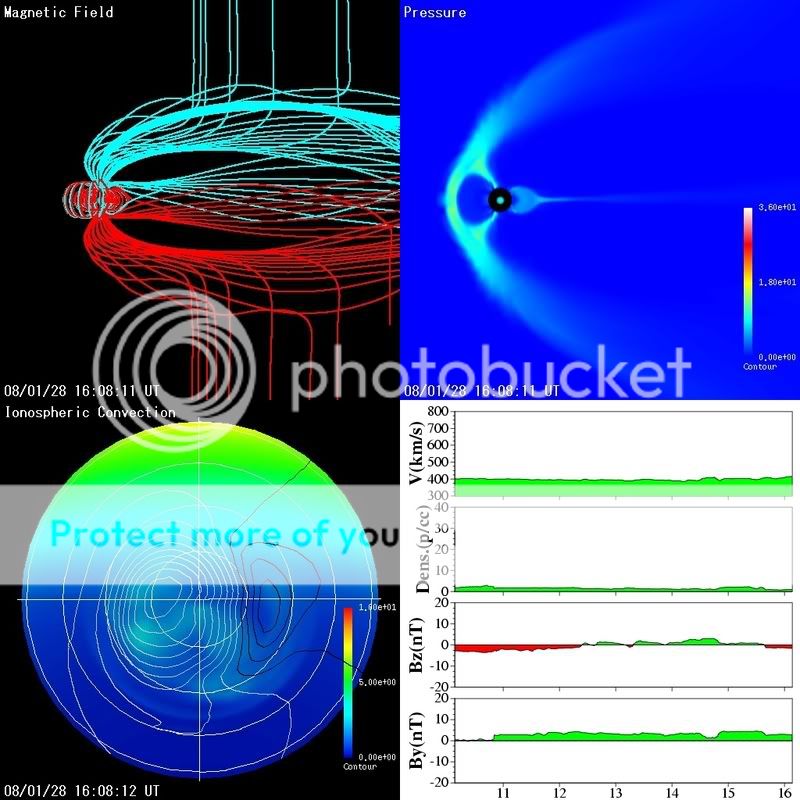
Being that I do not know that much about this I don't know for sure but it seems that the times I have looked (when Tu24 and BC15 were near) there was an increase in "pressure" among other things. Can someone explain the graphs that go with today's images and the "spikes" that occured? I'd like to know more. Thanks.
perceivedreality:
Here are the links you are talking about I think:
Home page:
www2.nict.go.jp...
"Latest Images" page:
www2.nict.go.jp...
Here are the most recent pictures and you are right the "pressure" of the magnetosphere is up (shown by white and red). This information is directly from the links above:

And here are the graphs that go with the "most recent" data:


For comparison purposes here are is an image from around the time Tu24 was at its closest:

And here are some images from the day before Tu24 was nearest. Notice the change in color ("pressure" I think):

Being that I do not know that much about this I don't know for sure but it seems that the times I have looked (when Tu24 and BC15 were near) there was an increase in "pressure" among other things. Can someone explain the graphs that go with today's images and the "spikes" that occured? I'd like to know more. Thanks.
reply to post by Moserious
It's very cool, but without knowing what are normal/average parameters, it doesn't seem possible to determine if something extraordinary is happening. It does seem like the magnetic field lines are possibly reacting to something, but I don't know if that happens all the time.
I have to say that I'm surprised at how poor our observation skills as a species are proving though. Maybe we'd better spend more money and attention on that.
It's very cool, but without knowing what are normal/average parameters, it doesn't seem possible to determine if something extraordinary is happening. It does seem like the magnetic field lines are possibly reacting to something, but I don't know if that happens all the time.
I have to say that I'm surprised at how poor our observation skills as a species are proving though. Maybe we'd better spend more money and attention on that.
Moserious-
Great Catch. Thanks for the info.
Using the JPL/NASA orbit modeler in hourly, I agree that it comes in to .0019au at what seems to be the 14th hour of the 31st(today). -if we are to believe the modeler?
What is immediately different about this asteroid vs TU24 aside from size is that TU24 hourly min distance progression modeled by Nasa showed 'NO' distance change over a period of 6 hours. (attributed to decimal crop/margin or error, etc.) For BC15 that min. distance from Earth near the EMOID changes over the period of a one hour 'click'.
Any guesses as to if this difference is attributed to the the different relative velocities of the two asteroids? TU24 was 9.25 (units?) where BC15 is supposedly twice that 20.69(units?).
Thanks again for the catch I will watch the data for the next few hours.
(edit) Whoa.. Just checked your Harvard link- they have speed as you say x4 of Tu24 at about 800 arcsecs/min. That would definitely account for the quick arrival at min nominal distance to the earth. I now wonder if the higher velocity helps keep the body on track and out of Earth's gravity influence?
Best,
scrap
[edit on 31-1-2008 by scrapple]
[edit on 31-1-2008 by scrapple]
Great Catch. Thanks for the info.
Using the JPL/NASA orbit modeler in hourly, I agree that it comes in to .0019au at what seems to be the 14th hour of the 31st(today). -if we are to believe the modeler?
What is immediately different about this asteroid vs TU24 aside from size is that TU24 hourly min distance progression modeled by Nasa showed 'NO' distance change over a period of 6 hours. (attributed to decimal crop/margin or error, etc.) For BC15 that min. distance from Earth near the EMOID changes over the period of a one hour 'click'.
Any guesses as to if this difference is attributed to the the different relative velocities of the two asteroids? TU24 was 9.25 (units?) where BC15 is supposedly twice that 20.69(units?).
Thanks again for the catch I will watch the data for the next few hours.
(edit) Whoa.. Just checked your Harvard link- they have speed as you say x4 of Tu24 at about 800 arcsecs/min. That would definitely account for the quick arrival at min nominal distance to the earth. I now wonder if the higher velocity helps keep the body on track and out of Earth's gravity influence?
Best,
scrap
[edit on 31-1-2008 by scrapple]
[edit on 31-1-2008 by scrapple]
reply to post by Moserious
Nice find. To answer your initial question, Yes. It happens all the time. As a matter of fact, it's not in the least uncommon for them to first identify asteroids AFTER they whiz by. A comforting thought, no?
Nice find. To answer your initial question, Yes. It happens all the time. As a matter of fact, it's not in the least uncommon for them to first identify asteroids AFTER they whiz by. A comforting thought, no?
Based on this and future 'short warning' arrivals. My curiosity is raised in the relationship between a forecast 'Spy satellite reentry story' and
this seeming increase in Asteroid activity/official awareness.
Something may indeed be 'up' for the month of Feb/early march.
Something may indeed be 'up' for the month of Feb/early march.
All of these asteroids flying by us recently got me thinking what if this is an alien race's attempt to either attack us or test our defensive
capabilities.
reply to post by 1Angrylightbulb
3. Practice - Don't piss off the bugs,
A third possibility harkens back to the late 80"s where the USSR would use Hawaii as the terminus (target) of its Pacific Missle range, We would take bets on whether the next shot would overshoot or undershoot us. Not sure if there were any agreements but the USSR tracking ships would regularly visit Honolulu.
Have their been any increases in UFO sightings?
3. Practice - Don't piss off the bugs,
A third possibility harkens back to the late 80"s where the USSR would use Hawaii as the terminus (target) of its Pacific Missle range, We would take bets on whether the next shot would overshoot or undershoot us. Not sure if there were any agreements but the USSR tracking ships would regularly visit Honolulu.
Have their been any increases in UFO sightings?
Here's something interesting on a related note...
www.newscientist.com...
Couple this news with the abundance of recently discovered NEOs, and the blood pressure rises just a bit...
www.newscientist.com...
www.newscientist.com...
On 25 January, the UK's Science and Technology Facilities Council (STFC) withdrew from the Gemini observatory in an effort to plug an £80 million budget gap. Astronomers from the UK are now almost blind to the sky above the northern hemisphere. "Gemini is one of the most visible signs of the problem that UK physics is facing," says Jim Wild at the University of Lancaster.
Couple this news with the abundance of recently discovered NEOs, and the blood pressure rises just a bit...
www.newscientist.com...
Makes me wonder if we are entering an unknown (to us) asteroid field. How can asteroids of this size just 'happen' in our solar system undetected?
And why is this a no mention in the press?
What will come?
Are there distant neighbors helping us? Do we have more advanced technology being implemented at this time, if so why not use this opportunity to disclose some of our latest technology?
Does this have anything to do with the release of information about the possible fallen satellite?
Are the recent sightings of UFO's ours and or our distant neighbors?
It just seems that there is so much more to this story than meets the eye.
Who was watching this as it passed and what data do they have for us? Is it a chunk of the last one or a completley different type?
So many questions, so little cooperation from the industry that we fund.
These observatories were not set up to be a part of the NWO and the Global elite.
What will come?
Are there distant neighbors helping us? Do we have more advanced technology being implemented at this time, if so why not use this opportunity to disclose some of our latest technology?
Does this have anything to do with the release of information about the possible fallen satellite?
Are the recent sightings of UFO's ours and or our distant neighbors?
It just seems that there is so much more to this story than meets the eye.
Who was watching this as it passed and what data do they have for us? Is it a chunk of the last one or a completley different type?
So many questions, so little cooperation from the industry that we fund.
These observatories were not set up to be a part of the NWO and the Global elite.
new topics
-
BIDEN Admin Begins Planning For January 2025 Transition to a New President - Today is 4.26.2024.
2024 Elections: 3 hours ago -
Big Storms
Fragile Earth: 4 hours ago -
Where should Trump hold his next rally
2024 Elections: 7 hours ago -
Shocking Number of Voters are Open to Committing Election Fraud
US Political Madness: 8 hours ago -
Gov Kristi Noem Shot and Killed "Less Than Worthless Dog" and a 'Smelly Goat
2024 Elections: 8 hours ago -
Falkville Robot-Man
Aliens and UFOs: 9 hours ago -
James O’Keefe: I have evidence that exposes the CIA, and it’s on camera.
Whistle Blowers and Leaked Documents: 9 hours ago -
Australian PM says the quiet part out loud - "free speech is a threat to democratic dicourse"...?!
New World Order: 10 hours ago -
Ireland VS Globalists
Social Issues and Civil Unrest: 11 hours ago -
Biden "Happy To Debate Trump"
2024 Elections: 11 hours ago
top topics
-
James O’Keefe: I have evidence that exposes the CIA, and it’s on camera.
Whistle Blowers and Leaked Documents: 9 hours ago, 17 flags -
Australian PM says the quiet part out loud - "free speech is a threat to democratic dicourse"...?!
New World Order: 10 hours ago, 15 flags -
Blast from the past: ATS Review Podcast, 2006: With All Three Amigos
Member PODcasts: 13 hours ago, 13 flags -
Biden "Happy To Debate Trump"
2024 Elections: 11 hours ago, 13 flags -
Ireland VS Globalists
Social Issues and Civil Unrest: 11 hours ago, 9 flags -
Mike Pinder The Moody Blues R.I.P.
Music: 14 hours ago, 8 flags -
BIDEN Admin Begins Planning For January 2025 Transition to a New President - Today is 4.26.2024.
2024 Elections: 3 hours ago, 7 flags -
What is the white pill?
Philosophy and Metaphysics: 13 hours ago, 6 flags -
Shocking Number of Voters are Open to Committing Election Fraud
US Political Madness: 8 hours ago, 6 flags -
Big Storms
Fragile Earth: 4 hours ago, 6 flags
active topics
-
Gov Kristi Noem Shot and Killed "Less Than Worthless Dog" and a 'Smelly Goat
2024 Elections • 60 • : Degradation33 -
Australian PM says the quiet part out loud - "free speech is a threat to democratic dicourse"...?!
New World Order • 7 • : 19Bones79 -
It takes One to Be; Two to Tango; Three to Create.
Philosophy and Metaphysics • 8 • : Compendium -
Big Storms
Fragile Earth • 16 • : rickymouse -
James O’Keefe: I have evidence that exposes the CIA, and it’s on camera.
Whistle Blowers and Leaked Documents • 14 • : 19Bones79 -
BIDEN Admin Begins Planning For January 2025 Transition to a New President - Today is 4.26.2024.
2024 Elections • 18 • : rickymouse -
RAAF airbase in Roswell, New Mexico is on fire
Aliens and UFOs • 12 • : pianopraze -
A Warning to America: 25 Ways the US is Being Destroyed
New World Order • 29 • : 19Bones79 -
What is the white pill?
Philosophy and Metaphysics • 22 • : AlexandrosOMegas -
University of Texas Instantly Shuts Down Anti Israel Protests
Education and Media • 315 • : CriticalStinker
